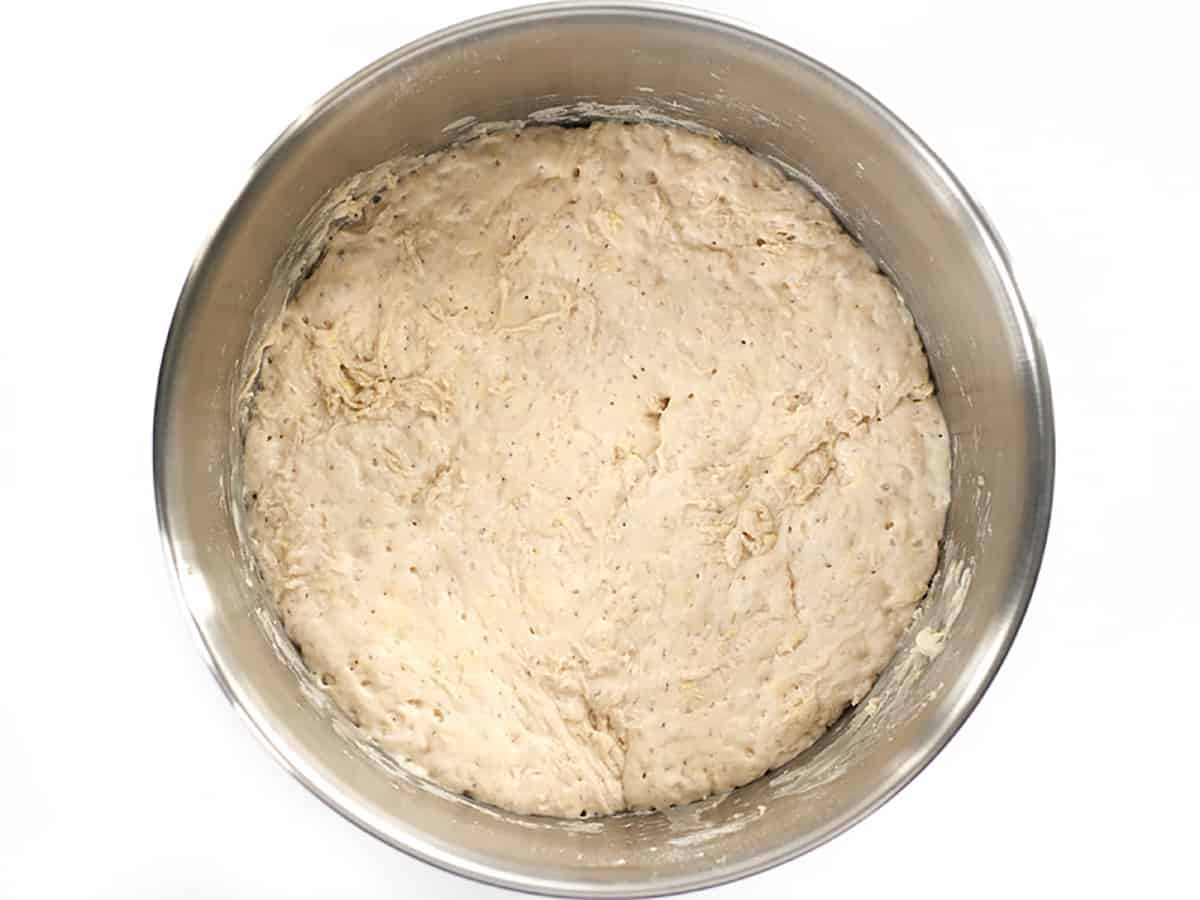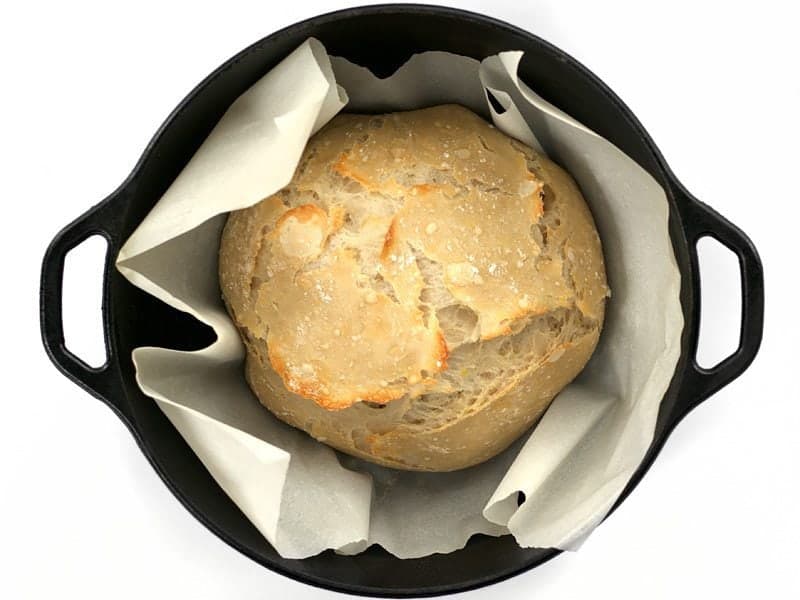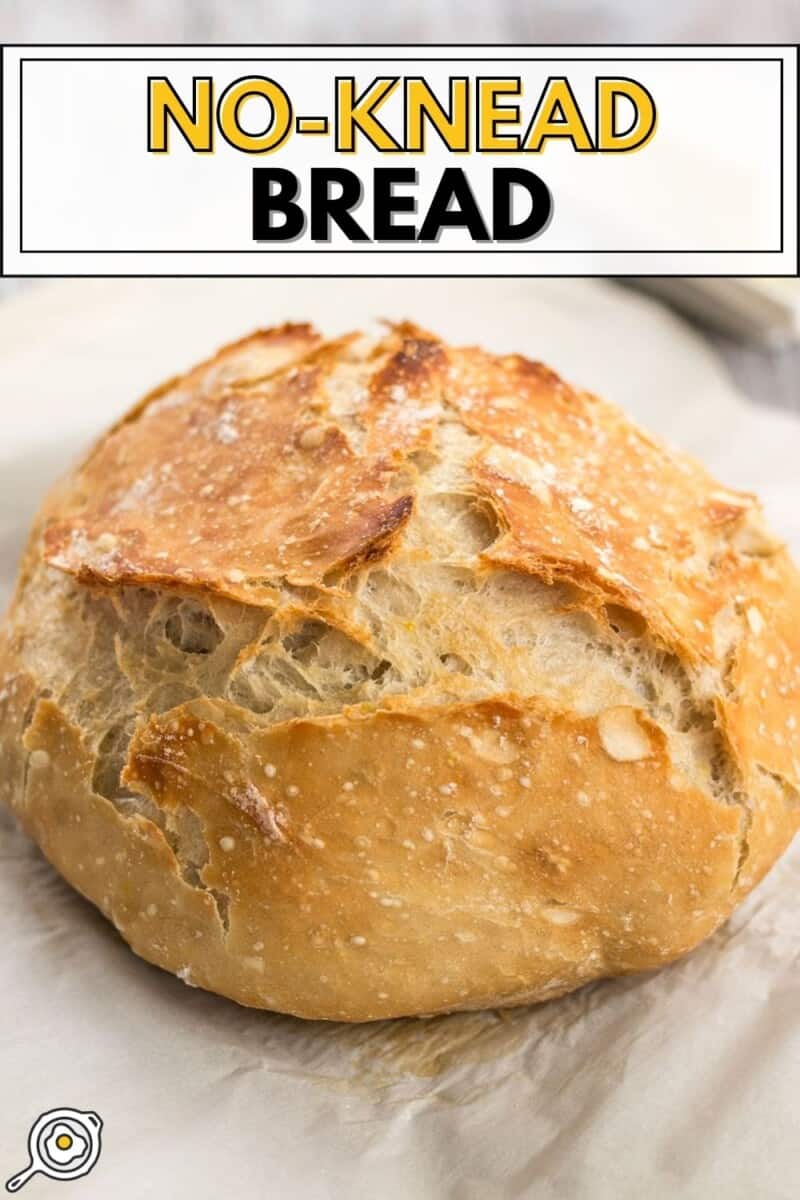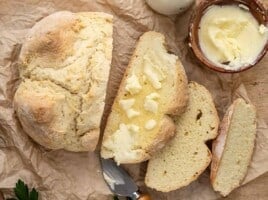I started making no-knead bread in 2010 and it has continued to be my favorite way to make homemade bread because it’s incredibly simple, it doesn’t require a lot of effort, and it makes the most deliciously crusty bakery-style bread ever. To make this no-knead bread recipe you only need four ingredients (including water) and a little bit of time. No fancy equipment or techniques needed!

This post contains some affiliate links, which means that we make a small commission off items you purchase at no additional cost to you.
“I’ve made this twice and it was amazing! Hard to believe something so simple can come together to be something so amazing!”
-Melissa
What Is No Knead Bread?
No-knead bread is an ancient technique for making delicious loaves of bread by utilizing a long fermentation time to develop the gluten the flour instead of hand kneading. Gluten is the protein that gives bread its strength, allowing it to rise into a fluffy loaf, and have that deliciously chewy texture. Kneading bread dough develops gluten quickly, but is quite labor-intensive. If given enough time, yeast can develop the gluten in the dough without the need for manual needing.
Ingredients for No Knead Bread
The best part about this no-knead bread recipe is that it only requires four ingredients, including water, and you still get an incredibly flavorful bread. Here’s all you’ll need to make your own homemade no-knead bread:
- Flour: Our version of no-knead bread was developed using all-purpose flour because that is what we most commonly have on hand. That being said, using bread flour will create even better results. Just keep in mind that bread flour tends to absorb more water than all-purpose flour, so you may need to adjust the ratios slightly.
- Yeast: For this type of bread, we use instant yeast or bread machine yeast, both of which do not need to be activated first by proofing in warm water. You can simply add them to your dry ingredients and go!
- Salt: Without the proper amount of salt, homemade bread will have no flavor, so it’s imperative that you do not skip the salt.
- Water: Water hydrates the flour to create the dough. Because this technique uses a longer ferment time, you can use room-temperature water and you do not have to “wake up” the yeast with warm water. The yeast will have plenty of time to activate as it rests.
What Kind of Yeast to Use
It’s very important to use the correct type of yeast for this recipe. Instant yeast and bread machine yeast are special because they do not require mixing with warm water to “wake up” before adding to a recipe. You can simply stir them into the dry ingredients and they will activate instantly upon hydration, so that is what we use for this super simple no-knead bread technique. Active Dry yeast, on the other hand, needs to be specifically activated in warm water first. If you use active dry yeast in this recipe using the technique below, the bread will likely not rise.
Do I Need to Use a Dutch Oven?
Using a preheated Dutch oven does create the best results because it gives the bread an extra intense boost of heat while retaining all of the moisture and steam. That being said, I have made no-knead bread on a sheet pan with great results! I suggest adding a pan with an inch or so of water on the bottom rack of your oven to create steam if you’re baking your bread on a sheet pan.
If possible, I would suggest investing in a Dutch Oven because they are easily one of the most flexible and useful pieces of cookware. We love our Amazon Basics 6-Quart Enameled Dutch Oven as a very affordable alternative to Le Creuset. Lodge also makes very affordable Enameled Dutch Ovens and plain Cast Iron Dutch Ovens (like the one used in the photos here).
Short Fermentation vs. Long Fermentation
You can make no-knead bread using either a long fermentation (12-18 hours) or a short fermentation (about 2 hours). The difference is that you’ll need more yeast to do the short fermentation and the flavor does not develop quite as deeply. That being said, short fermentation no-knead bread is a great option when you haven’t planned ahead!
Long Fermenation: Follow the instructions below, using ¼ tsp yeast and fermenting the dough for 12-18 hours.
Short Fermentation: Use 2 tsp yeast (or one ¼ oz. packet) and ferment the dough for about 2 hours at room temperature.

No-Knead Bread

Ingredients
- 3 cups all-purpose flour ($0.29)
- 1/4 tsp instant yeast or bread machine yeast* ($0.02)
- 1.5 tsp salt ($0.02)
- 1.5 to 1.75 cup water** ($0.00)
Instructions
- The day before baking, combine the flour, yeast, and salt in a large bowl and stir until they're well combined. Stir in about 1.5 to 1.75 cups room temperature water until a shaggy, sticky ball of dough forms and there is no dry flour left on the bottom of the bowl. The dough should be wet and sticky, but not so wet that it appears glossy. Cover the bowl loosely with plastic and let it sit at room temperature for 12-18 hours.
- The next day, the dough should be fluffy and very bubbly. When you're ready to bake, sprinkle a little flour on top of the fermented dough and scrape it out of the bowl. With well-floured hands, shape the dough into a ball and place it on a piece of parchment paper. Let the dough rise for 30-60 minutes.
- While the dough is rising, preheat the oven to 425ºF, or the highest recommended temperature listed on the packaging for your parchment paper. Place the Dutch oven inside the oven as it preheats, and make sure it sits in the fully heated oven for at least 15 minutes before baking the bread.
- Once the bread has risen and the Dutch oven is fully heated, carefully remove the Dutch oven from the oven (it will be EXTREMELY hot). Lift the parchment with the dough straight into the dutch oven and cover it with the lid.
- Return the Dutch oven to the oven and bake for 30 minutes. Carefully remove the lid and bake for another 15-20 minutes, or until the crust is a deep golden brown. Remove the Dutch oven from the oven, lift the bread out by by using the parchment paper, and allow it to cool before cutting open and serving.
Sheet Pan Instructions
- Ferment and shape the dough as described above, then place it on a parchment-lined sheet pan to rise for an additional 30 minutes.
- Place a baking pan with about an inch of water on the bottom rack of the oven, then preheat to 425ºF while the dough rises.
- Once the loaf has risen for 30 minutes and the oven is fully preheated, carefully score the top of the dough with a sharp knife (use horizontal motions with no downward pressure). Transfer the sheet pan to the oven and bake for 40 minutes, or until the crust is deeply golden brown and the loaf sounds hollow when tapped.
See how we calculate recipe costs here.
Equipment
- Cast Iron Dutch Oven
- Mixing Bowls
- Parchment Paper
- Liquid Measuring Cup
Notes
Nutrition

How to Make No-Knead Bread – Step by Step Photos

Before you begin, make sure you have “instant yeast” or “bread machine yeast” rather than “active dry”. The reason you need this type of yeast specifically is because it does not need to be kick-started by mixing with warm water first. You can add it to a recipe dry and it will still activate. I buy these little jars, which I keep in my fridge, and they last for-ev-er (especially when you’re only using 1/4 tsp at a time)!

The day before you want to actually bake the bread, combine 3 cups all-purpose flour, 1/4 tsp instant or bread machine yeast, and 1/2 Tbsp salt in a large bowl. Stir them together really well.

Stir in about 1.5 to 1.75 cups of room temperature water, or just enough to form a shaggy ball of slightly sticky dough, and no dry flour is left on the bottom of the bowl. The total amount of water needed may vary from time to time depending on the ambient humidity and moisture content of the flour, so go on visuals here. Make sure it comes together in one ball and no dry flour is left on the bottom of the bowl. It’s okay for it to be a bit sticky.

Loosely cover the bowl with plastic and let the dough ferment at room temperature for 12-18 hours. If you need to let it sit longer than that to fit your schedule, just transfer it to the refrigerator. As the dough ferments, it becomes very big, light, fluffy, and bubbly.

Sprinkle a little flour onto the dough (because it will be sticky) and scrape it out of the bowl. It will begin to deflate as you scrape it out.

Using floured hands, shape the dough into a ball, then place it on a large piece of parchment. Let the dough rise for 30-60 minutes. The shorter rise time will produce a slightly more dense bread and the longer rise time will have larger bubbles.

While the dough is rising, begin to preheat the oven and the Dutch oven. Set the oven to 425ºF, or whatever the highest safest temperature is for your brand of parchment (it will usually be listed on the box somewhere). Make sure your Dutch oven is inside the oven as it preheats, and then let it heat for an additional 15 minutes or so once the oven is up to temperature. This makes sure that the Dutch oven is nice and hot.

When the dough is risen and the Dutch oven is fully preheated, carefully remove the Dutch oven from the oven (it will be extremely hot!). Lift the risen dough by the parchment and place it inside the Dutch oven, parchment and all. Place the lid on the Dutch oven and return it to the hot oven.

Let it bake for 30 minutes with the lid on the Dutch Oven, then carefully remove the lid…

Then bake it for an additional 15 minutes or so WITHOUT the lid to allow the crust to brown.

Once the crust achieves a nice deep golden brown color, carefully remove the Dutch Oven from the oven. Lift the no-knead bread out of the Dutch oven by the parchment, and allow it to cool before serving.

And just be prepared for the BEST bread you’ve ever made yourself. ;) The crust on this no-knead bread is seriously amazing.
No Dutch Oven and Short Fermentation Instructions
So, as I mentioned before, you can still bake this bread without a Dutch oven and with a short, 2-hour fermentation time. Here is a photo of my no-knead bread using just 2 hours of fermentation (plus another 1 hr rise time) and baked on a baking sheet.

If you only have about 2-3 hours to ferment the dough, you’ll need to increase the amount of yeast used to 2 tsp (instead of 1/4 tsp).
Let the dough ferment in the bowl for 2 hours, then shape it into a loaf, transfer it to a baking sheet covered with parchment (and sprinkled with cornmeal, if desired) and let rise for about another hour. I like to make slits in the top with a sharp knife after the loaf has risen. Be careful though, if the knife is not sharp enough or you use too much downward pressure, it can deflate the dough.
Brush the surface of the dough with water, then bake it in a preheated oven (again, as hot as the parchment will allow, usually around 425ºF) for 30-40 minutes, or until the crust is nicely browned.







Hi,
should I use the program bake or conventional bake?
Thank you,
Silvia
I can’t cook or bake to save my life, but I’ve made this bread twice (once plain, once with sliced kalamata olives) and it turned out beautifully both times! Thanks so much for this recipe, it’s going in the regular rotation at our house!
It tastes amazing but it keeps coming out wide and flat rather than round. Any thoughts here on why?
It should puff up quite a bit in the oven. Are you using a Dutch oven to bake it or are you using a flat baking sheet? Is your oven fully preheated before you begin baking the bread?
Can’t wait to try this recipe this weekend! I wonder if I can use bread flour instead of all-purpose? Or would that cause it not to rise as well… I’m new to baking bread and very interested in the science behind the recipes!
With the quarantine I cannot find the instant yeast, I do have dry active yeast could I use that and if so how much would I need to use and what did change the recipe instructions? I’ve never made bread before so I don’t want to screw it up the first time you get discouraged. LOL. Thank you
The first time I made no-knead bread, I used active yeast, activated it first in a little bit of warm water, and just used a little less room temperature water. let it rise/sit for 15 hours, or around that. It was great!
I’ve done variations on this recipe for a few years — but this is the best one, Beth. I’m planning to play with adding fresh rosemary and other fresh herbs for variety. However, this is the easiest, best recipe for those who love the taste of artisan breads. The Dutch Oven continues to be the best investment I ever made in the kitchen — bought one at Sam’s Club years ago. It’s really heavy, but the results are simply spectacular. Thank you for bringing this recipe back!
Fantastic recipe – we’ve done it twice in one week already and loved it!
However both times we’ve had the baking paper completely stick to the base of the loaf :( Any tips on avoiding this? Always very said have to saw off the bottom curst of every slice.
Thanks again!
Happy to hear it Rory! You can sprinkle some flour down before you put the loaf onto the parchment. Or cornmeal too.
Great recipe, so easy, thank you! My daughter and I, both bread novices, baked it in a deep cast iron skillet. So much better than anything I ever made in my bread maker years ago.
Where have you been all my life???? If only I’d known how easy this is!!! My father and grandfather were professional bakers and frankly I was a little intimidated by the old man’s finesse with kneading, folding, rising, punching….it was like some kind of magic that summoned the aroma and tastes of Heaven. But this!!!! I don’t “need” any other bread! (Pun intended.) This 1. The BEST bread ever! 2. Cheap! 3)EASY!!! My life is forever changed for the better! Thank you!!!
Dutch oven won’t be coming in the mail for around a month.
But I did the baking sheet method, and then covered the dough using large stainless steel mixing bowl. This helped trap a lot of the steam and got some pretty good results.
Here’s a photo.
https://imgur.com/kUTMrHV
I have been making a variation of this bread for a few years and want to share this tip – beer! substitute a can or bottle of beer plus one tablespoon white vinegar for part or all of the liquid, set it to rise overnight and the results are as good as any sourdough!
My question is another Dutch oven related one–sorry if it has already been asked. Is the Lodge Cast Iron model mentioned at the top suitable for use on a smooth, glasstop stove? Or would an enamel-coated version be better? I do not yet have one, but it’s a piece of equipment that I see mentioned frequently.
Thank you!
Hi Lori, unfortunately I’m not sure what materials are safe for glass cooktops. That might be something you’ll need to ask the manufacturer, or Google to see if that info is available online somewhere. But personally, I like my enamel coated Dutch oven a lot better than the plain cast iron. It’s so much easier to clean. :)
This is seriously the most forgiving bread recipe I’ve ever used. The first go around I had a bit too much water and accidentally did 1/2 tsp instead of 1/2 tbsp of salt, but still somehow resulted in a delicious loaf with great texture! The second time I had too little water and as a result not a great first rise. The result? Still a great loaf!
Well dang. Now I just realized I did 1/2 teaspoon too. Never in my life have I seen 1/2 TBSP in a recipe! Now I know to keep an eye out..,,
I was scanning the replies to see if I could find out if adding more salt would be detrimental to the yeast rise and thanks to you ladies I’ve realized I only added 1/2 tsp as well. It definitely needed more salt than that. I will try this recipe again with the correct amount of salt and see how it goes!
Can you use self rising flour instead of all purpose and if so what adjustments would you suggest?
I didn’t have instant yeast, only active dry and it worked just as good! The bread came out great. I let it sit for 15 hours, rise for 45 minute, then baked the same as the recipe! It’s so good.
Did you proof the active dry yeast first or just throw it in and make it like the recipe states?
I just followed the recipe!
Because I have a Dutch oven smaller than a 5qt and this will be my first time to make bread, I don’t want to waste ingredients, can I cut the quantities in half?
Thank you for sharing your recipes!
You should be okay or you can follow the baking sheet instructions.